#the reckoning darwin
Explore tagged Tumblr posts
Text




i'm the overlord of the underworld cos i hold horror's hand!
33 notes
·
View notes
Text
Burn Noticed 4x13 Eyes Open
This is another lengthy podcast ep that runs about an hour and a half. What does it mean this time? Where lies the disagreement between the podcasters? 🤣🤣
Bri loves the starting scene in the hospital - the callback to the pilot with Fi kicking Michael awake and then saying that the bullet missed his heart because it's so small. "She's so scared for him, and it comes out in being mean to him. I like watching her be a bit more vulnerable and covering it up with absolute violence." (It is cute, and so very Fi.)
She also loves the scene with Madeline and Michael after the credits. "When there's not a lot of cuts and Burn Notice just lets the actors work themselves, especially in more emotionally wrought scenes, it's so good. It gives them an opportunity to actually perform and these two actors are so good together."
Then they get into a lot of discussion about Dennis the serial killer...
Chris: Everything about his look and performance is 100% intentionally doing Patrick Bateman from American Psycho.
Bri: But isn't that the thing? He's a delusional narcissist who was born into money and has an inherent distrust of anyone he thinks is lower on the social scale.
Chris: Dennis is killing criminals and there's a weird morality thing to it - he's got a manifesto, and that's a different kind of serial killer than the American Psycho serial killer.
And then it turns out Bri doesn't know American Psycho, so there's a diversion. These younglings and their missed cultural touchstones!
Chris: He looks like Patrick Bateman but he acts like a weird, unwashed Rorschach character and those two things don't jibe. Killing criminals and killing homeless people, it's a weird mish-mash - they're fundamentally different psychologies so this character makes no sense to me.
Bri: He's killing anyone he feels is lesser than, he's like Darwin's tool.
The discussion goes on along those lines for a while and neither of them are convinced by the other's arguments. (I don't think it's that deep, honestly. He's a BN plot device of the week, and he's killing criminals because that's the plot and he's killing homeless people to make absolutely sure he's unsympathetic to everyone and none of the viewers are buying into his version of vigilante justice, as opposed to the BN version of vigilante justice.)
Bri likes the fact that the plan has to drastically change because Michael can't manage to get away when Dennis comes home when he's so injured.
Bri: Unfortunately, it doesn't really come up again that he has to reckon with his team about the fact that he's physically incapable of doing things like he's used to. He lies to Fi about what happened to save his pride and I feel like that's something that should come up again - forcing Michael to accept help because his whole stoic lone wolf thing shit can't get him out of it forever. I was initially very excited about this moment but then they drop it immediately. (Yeah, they do. His injury is mentioned again and used for humour, but this is the only time it causes a problem.)
They love the scenes where Fi is trying to get Jesse to be friends again and he's all, "Our marriage is on the rocks!" Bri: Jesse pouting aggressively I find incredibly endearing for some reason, and I think Fi also found it kind of endearing. (She really did 🤣)
Then they start talking about Jason Tracey and how he's really good at writing the comedy in BN. Those scenes truly are a delight.
Michael talks to Sam on the phone about the bombs then goes back over to Dennis. Bri: This is one of the first times we've got to watch him become the alias. He sort of shakes himself and then he slumps and kind of bugs his eyes out and starts to breathe a little different.
Chris: This is a good episode for Jeffrey Donovan. He's legitimately creepy in this episode. Talking about my complaints with Dennis, Jeffrey Donovan is playing this type perfectly. He's doing a much better job of playing this kind of zealot serial killer. (JD's acting is generally great, it's a huge part of the show.)
Michael and Sam use a flower delivery pretense to get close to the guards outside a house and disarm them, and then the guard throws the bouquet to the floor in frustration. Sam says, "Hey, pick that up! I worked hard on that bouquet!" and the guy actually does pick it up.
Bri: Sam is someone who really commits to the bit. He enjoys the drama of it, so I always like when Sam's around. (❤️)
Jesse deliberately detonates the bomb, and that goes down incredibly well with the podcasters.
Bri: Fucking dope move. That's the second time this episode that a really violent thing has happened unexpectedly and I think it really works. Jesse's like, "I'll help, but also kind of fuck you guys." I am digging this arc for him. (It is one hell of a wow moment 💯🤩)
It gets to be a great episode of BN easily, but not a great episode of television.
Bri: It's a perfectly serviceable action episode, it's very exciting to watch, but if you take a step back for a second, there are choices that don't thematically jibe. There were some thematic things they set up that were interesting but they didn't quite follow through with.
Chris: If they'd maybe pulled off that thing with Michael and his injury, that would have pushed it over the edge.
Bri: Totally. Because then the episode becomes about Michael Westen having to reckon with his own limitations, which is an interesting character study.
I definitely agree they could have done more with that, but it will be a little while longer yet before BN commits fully to being an arc plot show...
14 notes
·
View notes
Text
(i'm struggling with this chapter and for the most part. what's difficult for me is that "what exactly does 'evolution' mean in blue lock, anyway?" is the kind of question i wanted a hard answer for and in this chapter i got one, and the answer is just... pseudoscience... i enjoy engaging with blue lock's worldview but this is a scenario where my own beliefs run up against blue lock's and creates a muddy wall, i mean i'll still try but lord. nobody read blue lock)
anyway what i found most interesting about this whole mess was the unbridgeable gap between the original theory of evolution and the way blue lock can't help but rely on it when advancing its own pseudoscientific theory and how this feeds into the already present ambivalence within blue lock (manga). darwin's theory of evolution doesn't attribute any inherently superior or inferior quality to evolved traits (to use the manga's example, having a long neck doesn't make one inherently better/stronger, it just means survival within a certain environment becomes more viable)— if blue lock wants to rely on this theory to develop its own, it has to concede that an organism (read: individual) that survives within a specific environment won't necessarily be better/stronger than an individual that couldn't survive. applying this to isagi's quest to win within blue lock— just because he survives to become the best here doesn't mean he was actually the best or strongest, it just means he survived within this environment. if blue lock's reliance on the actual theory of evolution is as strong as it thinks it is, there may come a day when the manga's story must reckon with this
9 notes
·
View notes
Text
Pancakes Household: Chapter 9, Part 11
To ditch career day... or to not ditch career day...
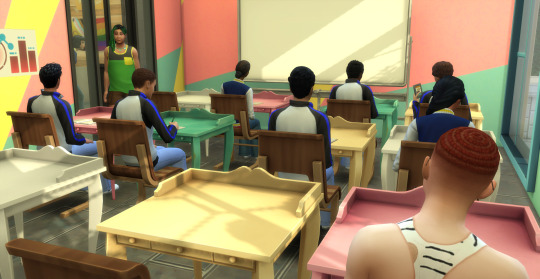
CW: Distressed infant
Since Tiana cannot speak her thoughts will often be in brackets
While Eliza and Bob have taken infant leave from their jobs, there is no such option for the teens. Fergus and Onyx pop their heads into the nursery where Bob is still rocking a sleeping Tiana and kiss her goodbye for the day. Then school awaits!
It looks like the Pancakes may have missed the outfit memo for today, oops. While Onyx heads off to find some friends Fergus tries to hastily finish the homework he neglected to finish. Unfortunately his friends are not much help this morning.
Anya: I look fabulous, thank you watcher
Artemisia: Are you staring at my best bracelet friend
Darwin: What? No. I was looking for the bus
Artemisia: Looking for the bus while we’re at school, unlikely
Atlas: I don’t think he meant anything by it
Fergus: Hold up- what did you guys get for 13?
Artemisia: Look dude, just keep your eyes to yourself
Darwin: Sure, and you can keep your venom to yourself
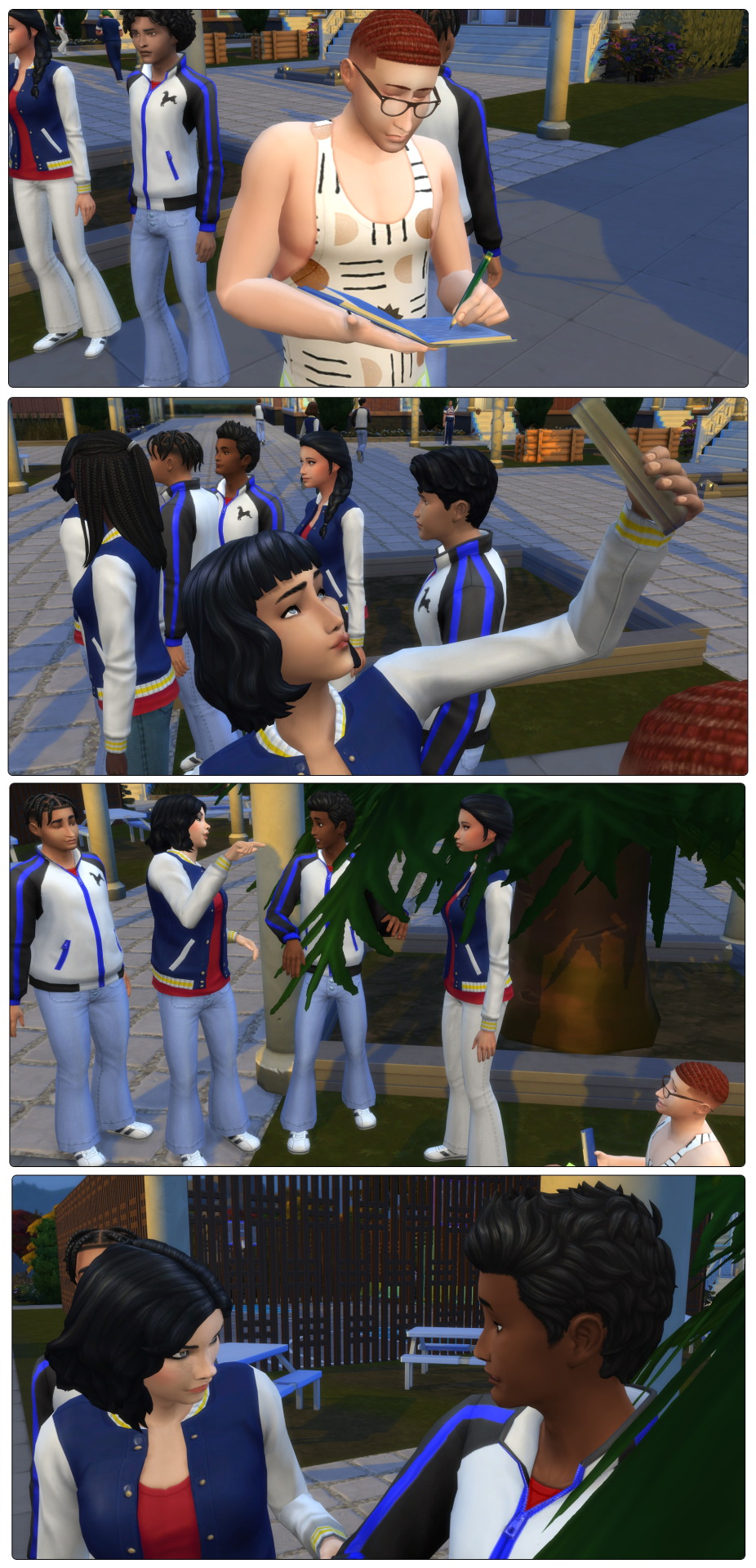
Outside the main building Onyx and Paola have some time relaxing.
Onyx: Aim for the centre
Paola: Of course I’m aiming for the centre dummy
Zhafira: Onyx! Hey! Look who caught the bus again successfully!
Zhafira approaches the pair beaming happily.
Onyx: Congrats. Did you hear they’re shuffling classes today
Zhafira looks downcast while Onyx explains the younger and older students will be having combined classes for the morning. They'll be with some of their friends but not Zhafira who seems upset at having to get to know even more new people.
As this is happening Mrs Tinker and Mrs Hensley come over and try give Paola some tips for successful throwing. Unfortunately they have contrasting opinions and in the end the teens decide the safest option is just to pretend they’ve gotten bored and head inside.
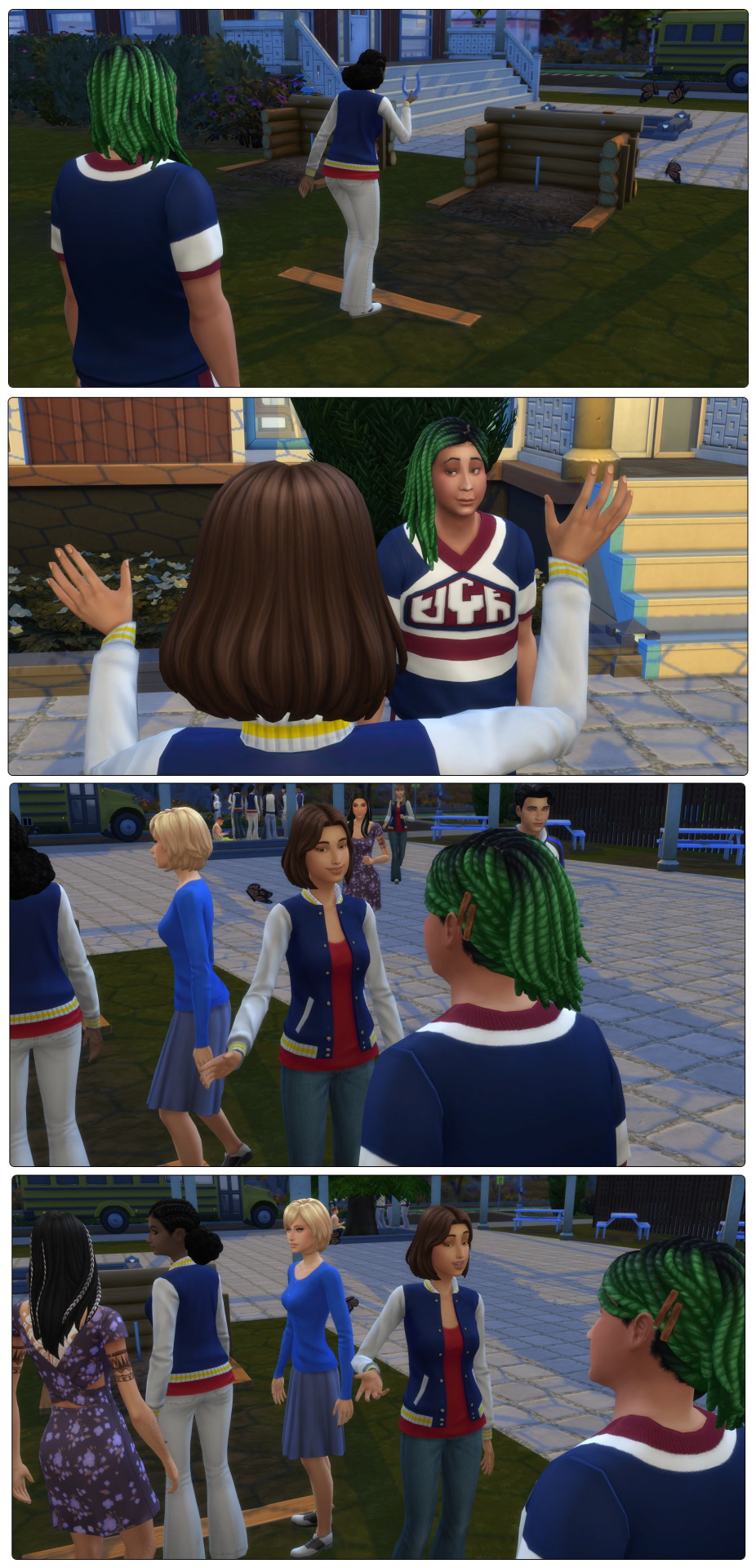
Onyx takes a quick swim before class and still manages to get to the room before the teacher begins the lesson.
Mrs T: Today we will be buddying up. Older students please join a younger student and we will begin designing a business for this scenario
Onyx: Mrs T can’t I just buddy up with Amie since she’s beside me
Mrs T: Sorry Onyx but Mr A wants to foster whole school cooperation, that's why we're having staggered classes this morning
Carson: I wish William had been put in here
Darwin: Don’t worry, we’ll see him at lunch
Carson: And I wish some outfits didn’t make my glasses vanish, it's like I've been dressed by a computer
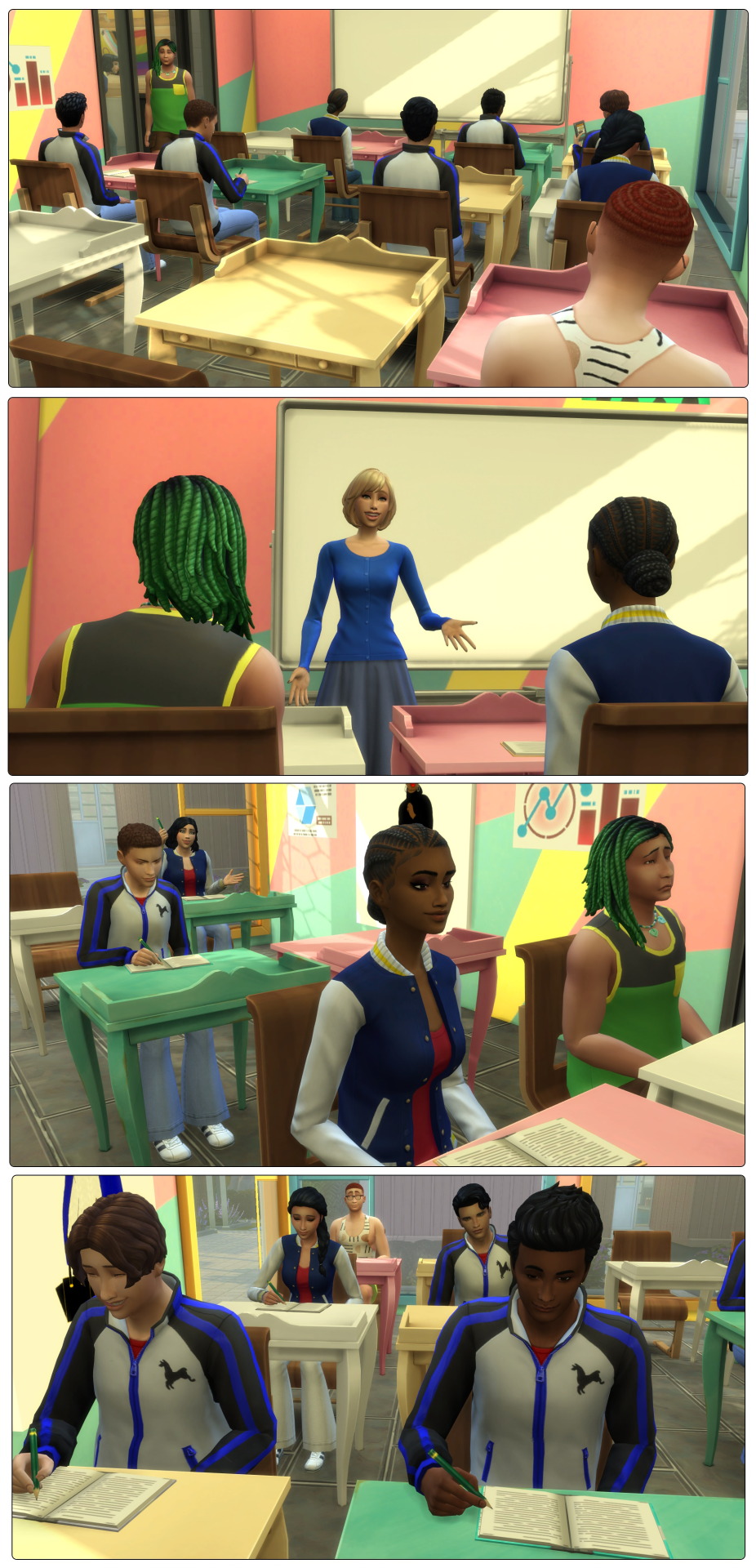
After class wraps up Fergus goes to talk with Artemisia.
Fergus: I’m excited to see what we’ll learn this afternoon
Artemisia: *sighs* Don’t be too excited, it’s career day
Fergus: You’re not punking me, we only just started high school. There is no career day
Artemisia: I’m serious. I’m also thinking of skipping out on it
Fergus: We can do that?
Artemisia: I reckon I can, question is do you have the guts to
Fergus: Of course I do. Onyx was still feeling ill this morning so we can use that excuse to head home
Artemisia: May the best person not be caught
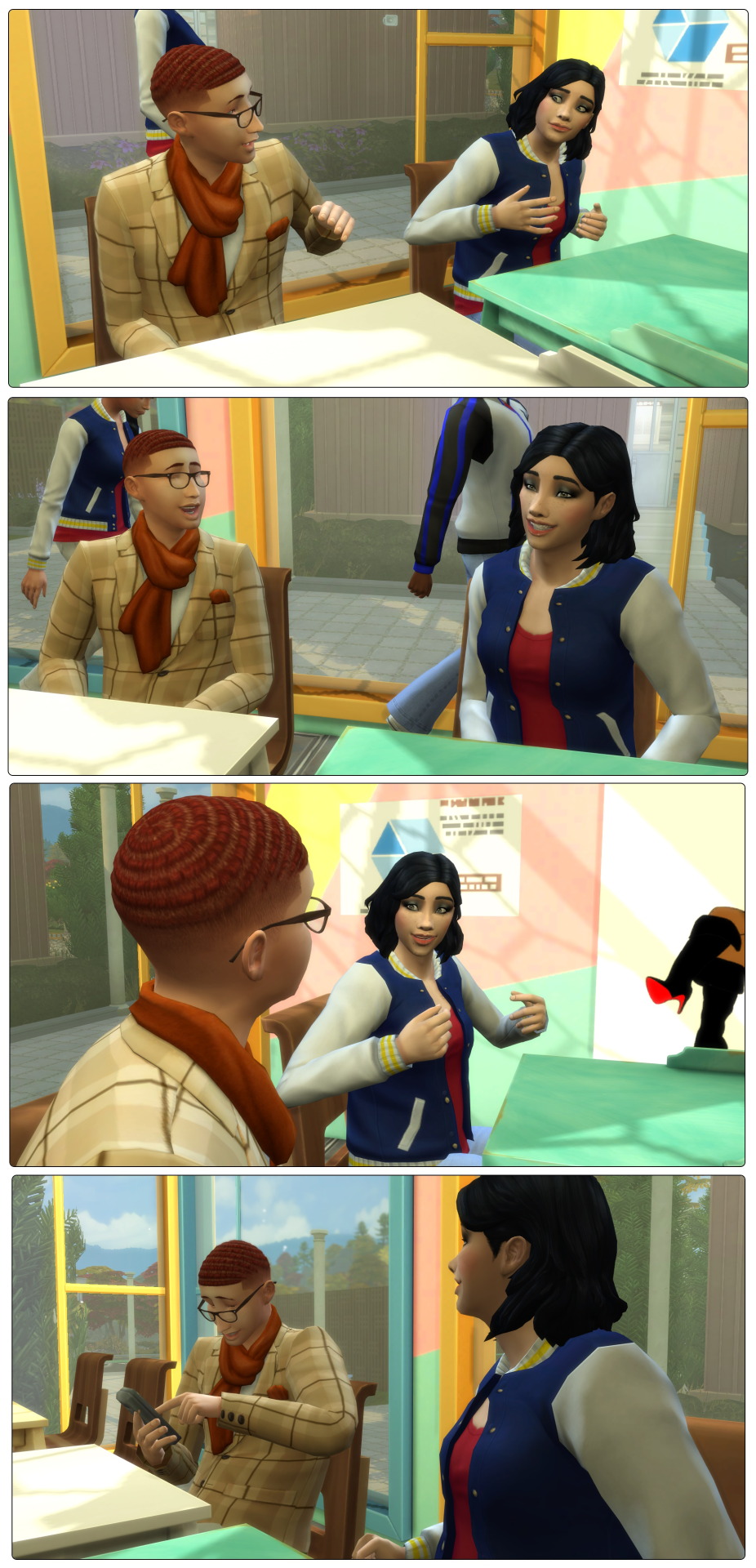
Back home Eliza is carrying Tiana when the infant fusses to be put down.
Eliza: Okay then, down we go
Tiana: *coos* (I coo now mother) *coos louder*
Eliza: Was that a coo? Was that a coo? I think it was *claps*
Tiana smiles and sticks her fingers in her mouth. Mother is pleased, she must be doing well. Even though mother keeps saying the word go, Tiana is happy they haven't seemed to leave the house.

Eliza is busy feeding Tiana when Fergus walks through the room.
Eliza: Hold on! What are you doing home?
Fergus: Umm, Onyx’s head got bad again so we came home so they could get a nap
Fergus walks over to the suckling infant and holds her hand for a bit. Tiana doesn't seem to grip back yet but she's looking at him curiously.
Eliza: You came home so Onyx could nap? I don’t think so. Onyx is capable of napping by themselves
Fergus: Fine, it was career day! I don’t need to worry about that yet. I’ll do extra homework tonight I promise
Eliza burps Tiana who spits up down her back.
Eliza: Ugh. it's okay honey, we can clean that up
Fergus: Want me to grab a cloth
Eliza: Please. Now I do not want you skipping school again, but since you’re here you can walk Strawberry since you're keen to help Onyx
Fergus: But I want to- *sighs* yes mother

The house is left quiet for Onyx’s nap while Bob takes Ginger for a run and Fergus takes Strawberry for a walk.
Eliza: Come on my snuggly sleeper. You get comfy back there and you can nap while mother does her run
Tiana: *coos questioningly* (wait, no, not outside! I don't want to leave) *cries* (I want to stay with mother)
Eliza: It's okay Tiana, mother is right here with you. We're just going to check out the neighbourhood huh. You'll be okay
Eliza jogs off and keeps talking to Tiana. Eventually the regular bouncing of the back carrier and the softness of Eliza's voice lull Tiana to sleep. Eliza is delighted to hear a quiet snuffling snore at her back as she runs.

Later that day...
Fergus: Dad?
Bob: Yes
Fergus: Umm, Tiana is crying. Don’t you think you should go give her a nap rather than carry her on your back
Bob: But- she’s learning with me though
Eliza: Fergus is right Bob, she’s exhausted. Better giver her to me
Bob: But I want to spend time with her
Eliza: And so you can, when she’s awake. You know she had a hard night, she needs to catch up on sleep still
Bob: *sighs* fine. Here Tiana honey, go with your mother *whispers* I'll teach you how to cook later though
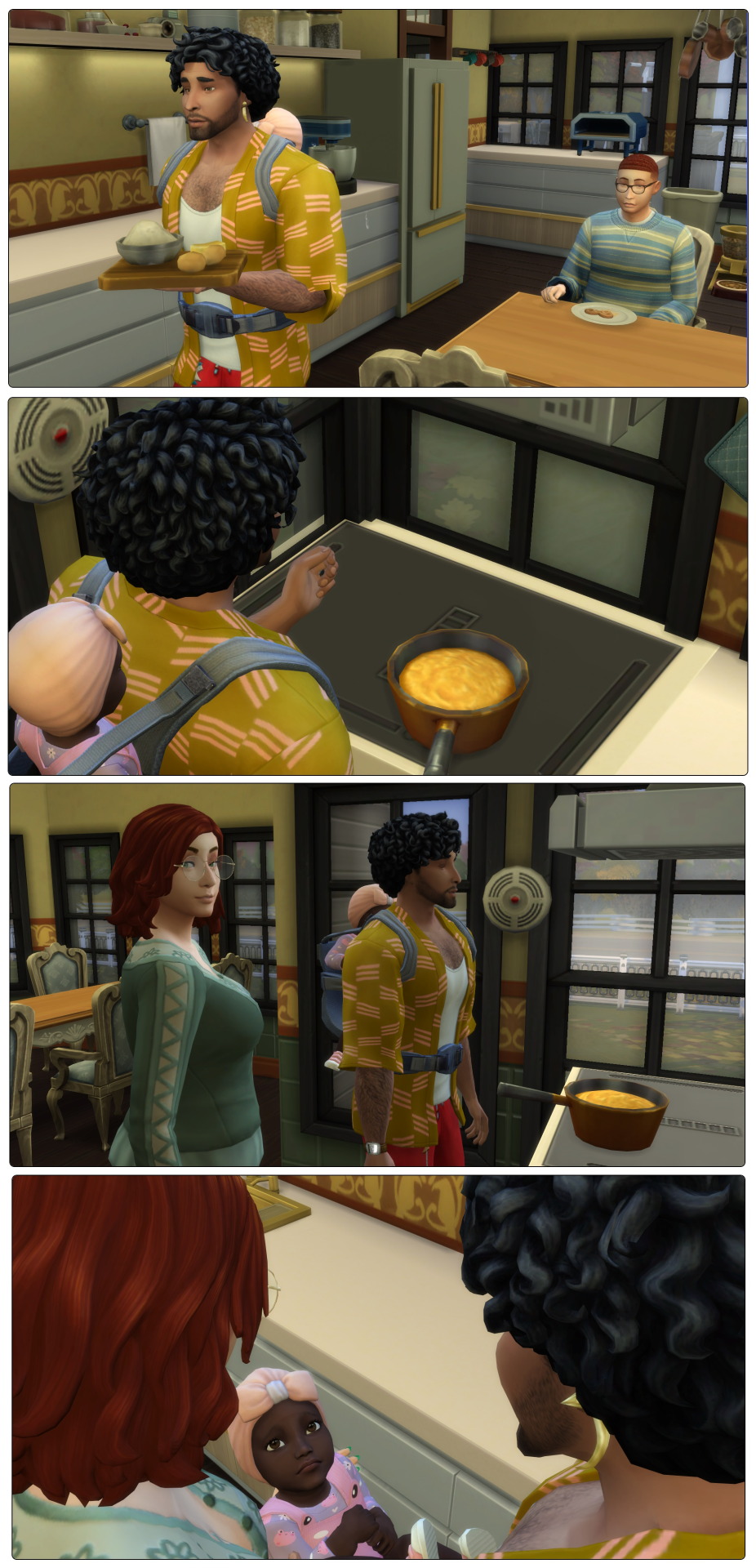
Eliza carries a grumpy over tired infant into the nursery and sits down with her in the rocking chair.
Eliza: There there Tiana, it’s okay, you just go to sleep
Tiana: *coos* (mother came back with me, I not left behind) *yawns*
Eliza: It's okay my sleepy girl, mother is right here and daddy is just down the hall. You can sleep, I'll keep you safe
Tiana does feel very tired and so she yawns and falls asleep in Eliza’s arms. It may not be winning a Nobel Prize but Eliza feels pretty proud of finding time in her schedule to snuggle with her daughter.

The teens decided to do their homework at their own desks tonight! Fergus was working away on some science as he has a class trip to the aquarium tomorrow. Onyx meanwhile did their best to study for their exams. After Onyx felt like they could confidently say they were no longer sick they went and did some cheer practice. Later in the evening Tiana woke up.
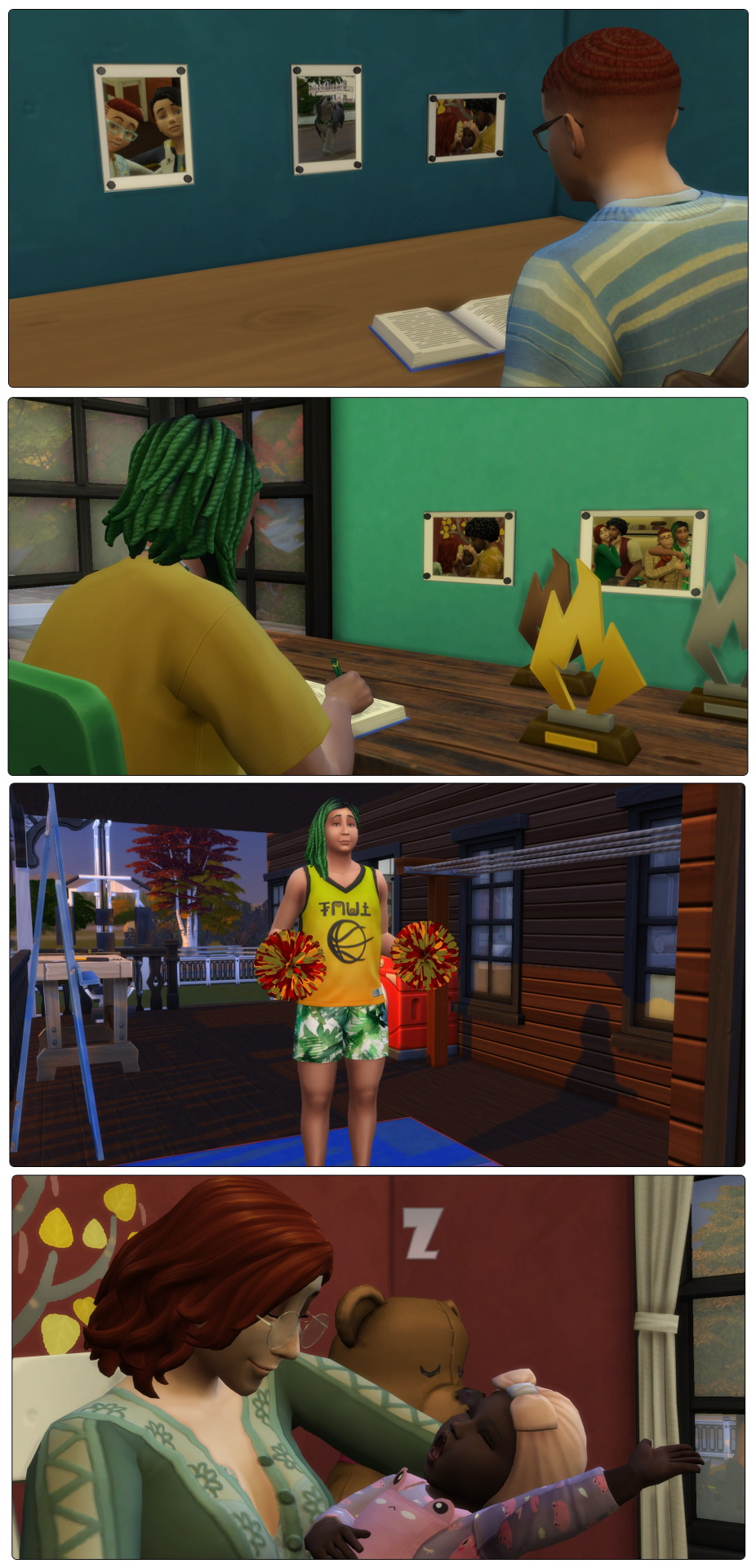
After a diaper change Eliza gets Tiana into a clean night onesie and goes in search of Bob.
Bob: Thank you for the suggestion. She’s given us so much joy already
Kayleigh: No problem at all I- oh is this her?
Eliza: *grinning* Kayleigh may I introduce our youngest? This is Tiana
Kayleigh: Oh she is precious
Bob: Come to daddy, did you have a nice nap
Eliza: She’s still quite tired, I think she’ll need a proper sleep after her bottle
Bob: We can do that
Kayleigh: I best get going, see you all later
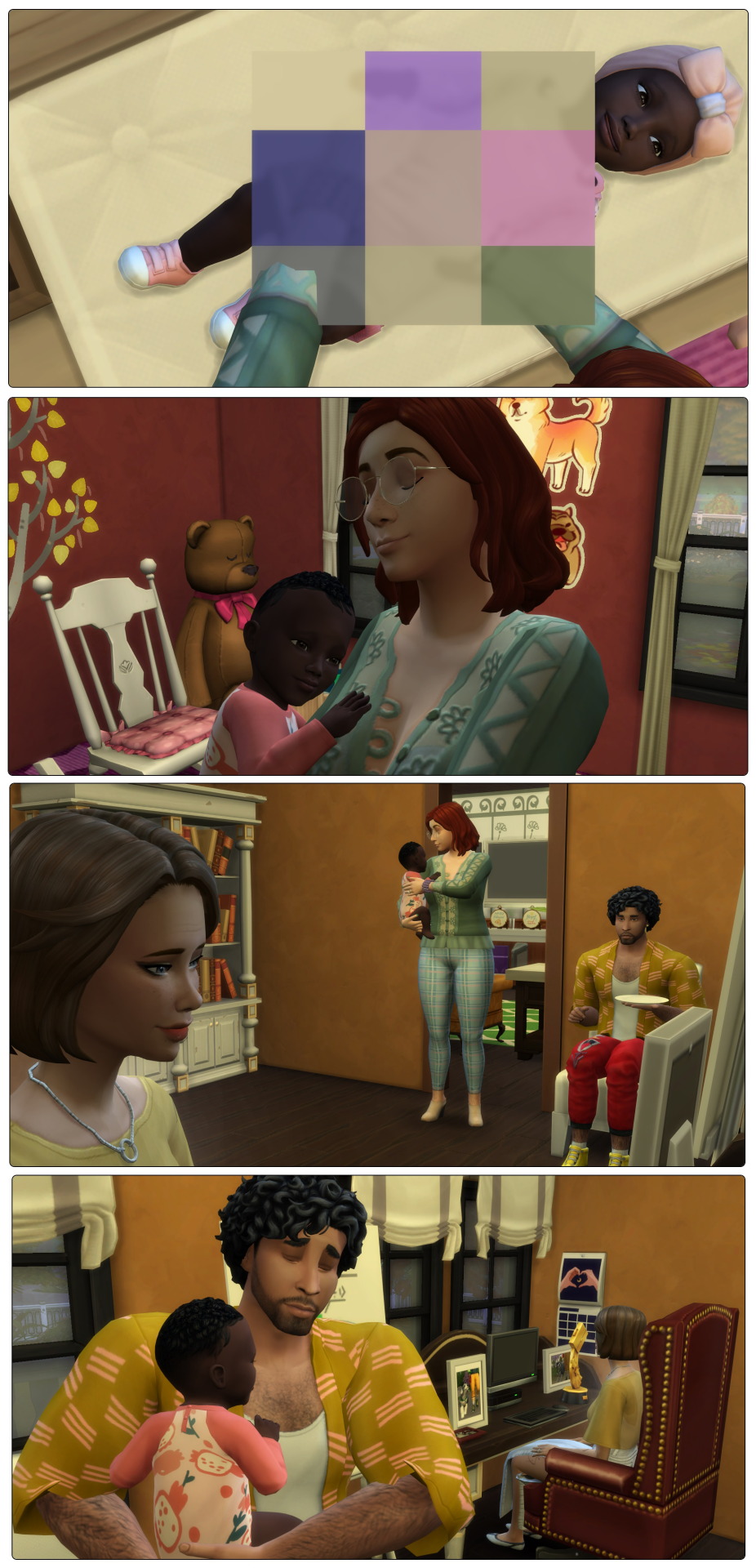
Bob: Can you say bye bye to Kayleigh
Tiana: *coos and snuggles into shoulder* (daddy is here, mother found him for me)
Bob: *chuckles* okay, food time then
Bob is delighted to see Tiana has a healthy appetite. He prepares himself to be spat on but to his surprise only gas comes out. Snuggling Tiana close he carries her down the hall and places her in her crib. He softly tells her another tall tale and the exhausted infant falls asleep happy with the sounds of fellow sims.
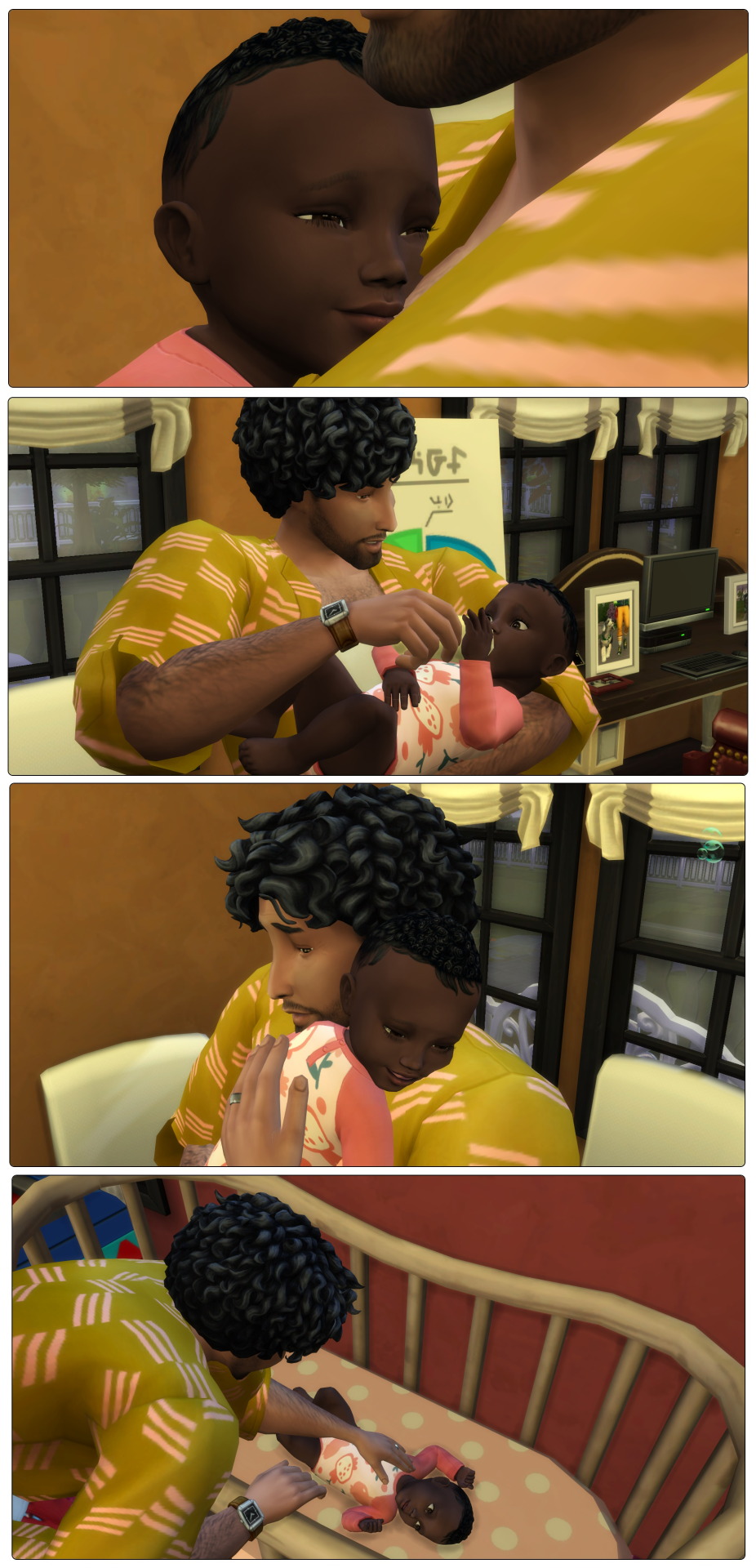
Previous ... Next
#sims 4#the sims#the sims 4#simblr#my sims#ChangingPlumbobStorytime#R0904#FergusPancakes#OnyxPancakes#ArtemisiaYork#CarsonFoster#BobPancakes#ElizaPancakes#TianaPancakes#KayleighFoster
23 notes
·
View notes
Note
RE: [I think a question people should ask themselves when exploring spirituality and mysticism more is, "is this just making hyperindividualism, AKA being a totally self-centered asshole, look cool and deep?"]
Please elaborate?
Self-centered assholes who like to reckon themselves spiritual (or would like to play out the role of a great spiritual leader) will inevitably find ways to spin their selfishness as great spiritual enlightenment. Neville Goddard, for example, basically packaged hyperindividualism under capitalism into a form of mystical practice he called the Law of Assumption. Like he didn't totally invent this; the Law of Assumption is basically a New Thought redux, but basically it's all American capitalist bullshit presented as spiritual enlightenment. He even makes up all this stuff about it supposedly being part of Kabbalah and Jesus's disciples actually being secret LoA practitioners.
Meanwhile in witchcraft communities there's always been various people who try to spin some kinda social Darwinism as the way to be a witch. They basically loathe the idea of behaving in pro-social, community-minded ways and justify it with rhetoric about every true witch finding their own way, relying on their own discernment, relying on their own power, etc. You have people who think that if they can magically summon oodles of money, they have no obligation to share it with anyone, because if other people aren't powerful enough to summon their own money, that's their problem. I wrote a bit more about toxic individualism in witchcraft over here.
Oh, and apparently, Anton LaVey was strongly inspired by Ayn Rand, and went on record saying "I give people Ayn Rand, with trappings." Ayn Rand, of course, was the epitome of capitalist ghoulishness and the kind of hyperindividualism it fosters.
So yeah, people really need to be more aware that people will really just spiritualize the most awful, self-centered attitudes and spin it as profound enlightenment. This is why it's important to look past the awe-inspiring prose and ask yourself "what is it actually saying about humanity, the world, and my relationship to it?"
33 notes
·
View notes
Text
I'm studying for my ecology exam and got distracted.
So natural selection increases favorable traits and decreases unfavorable traits in a population. Darwin and his birds. Survival of the fittest, yada yada.
In my notes, it's described as "favored individuals pass down their good genes to the next generation". And, being silly, thought of "Good Genes" from 2003.
And the two wolves inside me (the bio nerd and the English nerd) did a team-up, and now I'm must share their findings.
Before, "Good Genes" was just a fun, alliterative title that foreshadowed Donnie's transformation. But things get interesting when we put a "survival of the fittest" spin on the concept.
In any typical environment, an organism with a superb offensive and a strong defense, like monster Donnie, would be favored by natural selection. Hell, his brothers stand no chance against Donnie without the technology Leatherhead/ EPF provides. He's a force to be reckoned with, so much so that Bishop considers putting Donnie down when he escapes. Basically, this version of Donnie is an organism that can survive almost anything thrown at it.
One of my few complaints about these episodes was that Donnie's monster design could be used for any one of his brothers; it wasn't special to him. Maybe that's the point. Donnie is turned into a monster fit for violence and destruction, something so unDonnie that it fails to even resemble him. These "good genes" suck anything that made Donnie, Donnie out in favor of a monster.
Maybe the real good genes were his brother's perseverance and resolve to help Donnie at any cost. The turtles are strong, not because they're physically the strongest, but because they're a unit, a family. They're strongest when they combine their unique talents and work as one mind. Perhaps the good genes were the family we made along the way.
#i know monster donnie's cells were decomposing and he was going to die but ignore that for the sake of me looking way too into things#biology is so cool you guys#tmnt#tmnt 2003#tmnt donnie#tmnt bishop#2003 tmnt#2003 donnie#2003 bishop#tmnt good genes
23 notes
·
View notes
Text

Travel Destination: Trinidad and Tobago
Bumps in the Night by Amalie Howard
Darika “Rika” Lovelace is in trouble. The kind of trouble that sends her to her grandmother’s estate in Trinidad for the whole summer. But something about the island feels…different. As soon as she steps off the plane, strange things start happening.
Rika meets a group of kids called Minders, who seem to have elemental powers. Even worse, she can sense jumbies lurking in the shadows. Needless to say, she wants a ticket home. But when the Minders let slip that her long lost mum is in danger, she knows she can’t leave.
The Jumbies by Tracey Baptiste
Corinne La Mer claims she isn’t afraid of anything. Not scorpions, not the boys who tease her, and certainly not jumbies. They’re just tricksters made up by parents to frighten their children, right. Then one night Corinne chases an agouti all the way into the forbidden forest, and shining yellow eyes follow her to the edge of the trees.
When Corinne spots a beautiful stranger at the market the very next day, she knows something extraordinary is about to happen. When this same beauty, called Severine, turns up at Corinne’s house, danger is in the air. Severine plans to claim the entire island for the jumbies. Corinne must call on her friends to stop Severine and to save her island home.
When We Were Birds by Ayanna Lloyd Banwo
In an old house, Yejide’s mother is dying. She is leaving behind a legacy that now passes to Yejide: The power to shepherd the city’s souls into the afterlife. But after years of suffering her mother’s neglect and bitterness, Yejide is looking for a way out.
Raised in the countryside by a devout Rastafarian mother, Darwin has always abided by the religious commandment not to interact with death. But when the only job he can find is grave digging, he must betray the life his mother built for him in order to provide for them both. Newly shorn of his dreadlocks and his past, and determined to prove himself, Darwin finds himself adrift in a city electric with possibility and danger.
Yejide and Darwin will meet inside the gates of Fidelis, an ancient and sprawling cemetery, where the dead lie uneasy in their graves and a reckoning with fate beckons them both.
One Year of Ugly by Caroline MacKenzie
After fleeing crumbling, volatile Venezuela, Yola Palacio wants nothing more than to settle into a peaceful new life in Trinidad with her family. And who cares if they're there illegally, But life for the Palacios is far from quiet and when Yola's Aunt Celia dies, the family once again find their lives turned upside down. For Celia had been keeping a very big secret--she owed a LOT of money to a local criminal called Ugly. And without the funds to pay him off, Ugly has the entire family do his bidding until Celia's debt is settled. What Ugly says, the Palacios do, otherwise the circumstances are too dreadful to imagine.
When the Vibe is Right by Sarah Dass
When the future of Grandeur, her family’s masquerade band nears the brink of collapse in the face of band rivalry, Tess finds to her chagrin that she must team up with Brandon her irritating classmate in a desperate attempt to revive the company.
As Tess and Brandon spend more time together, Tess begins to wonder if everything she thought she knew might not be so certain after all
#booklr#world reading challenge#read around the world#bookblr#trinidad and tobago#bumps in the night#amalie howard#the jumbies#Tracey Baptiste#when we were birds#Ayanna Lloyd Banwo#one year of ugly#Caroline MacKenzie#when the vibe is right#Sarah Dass#middle grade#horror#mg#magical realism#contemporary#romance#ya#young adult
4 notes
·
View notes
Note
Happy Storyteller Saturday! It's Valentine's Day, or a similarly romantic occasion, how do your characters celebrate? (I'd love to hear about the unattached characters just as much as the ones in relationships.)
Thanks for the ask 💜
I can't imagine any of my characters actually celebrating valentine's day. The ones in established relationships definitely aren't valentine's day kinds of people. Project Darwin might go that way later because Tobie is a hopeless romantic, but I'm not at that point in the story yet.
As for the unattached ones, I reckon Aria (who is aro-ace) from Name From Nowhere would get a kick out of buying ridiculously packaged Romance Chocolate on sale the next day and eating it while she plans a heist.
#answered asks#writeblr tags#sts#storyteller saturday#name from nowhere#project aria#project darwin#writeblr#writers on tumblr
8 notes
·
View notes
Text

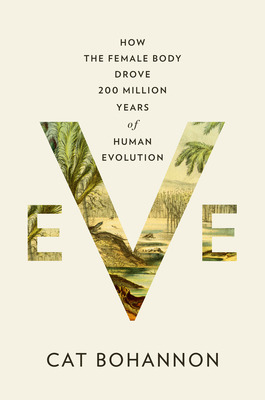
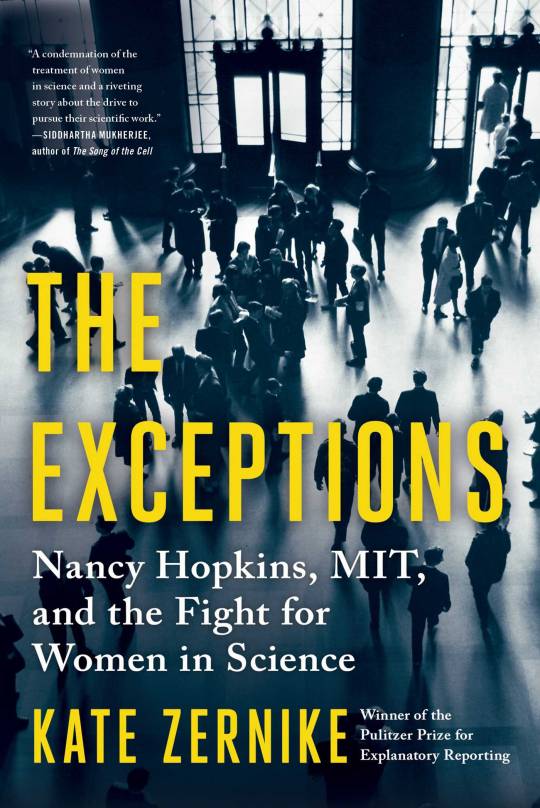

Read-Alike Friday: Bitch by Lucy Cooke
Bitch by Lucy Cooke
Studying zoology made Lucy Cooke feel like a sad freak. Not because she loved spiders or would root around in animal feces: all her friends shared the same curious kinks. The problem was her sex. Being female meant she was, by nature, a loser.
Since Charles Darwin, evolutionary biologists have been convinced that the males of the animal kingdom are the interesting ones - dominating and promiscuous, while females are dull, passive, and devoted.
In Bitch, Cooke tells a new story. Whether investigating same-sex female albatross couples that raise chicks, murderous mother meerkats, or the titanic battle of the sexes waged by ducks, Cooke shows us a new evolutionary biology, one where females can be as dynamic as any male. This isn‘t your grandfather’s evolutionary biology. It’s more inclusive, truer to life, and, simply, more fun.
Eve by Cat Bohannon
How did the female body drive 200 million years of human evolution
Why do women live longer than men?
Why are women more likely to get Alzheimer’s?
Why do girls score better at every academic subject than boys until puberty, when suddenly their scores plummet?
Is sexism useful for evolution?
And why, seriously why, do women have to sweat through our sheets every night when we hit menopause?
These questions are producing some truly exciting science – and in Eve, with boundless curiosity and sharp wit, Cat Bohannon covers the past 200 million years to explain the specific science behind the development of the female sex: “We need a kind of user's manual for the female mammal. A no-nonsense, hard-hitting, seriously researched (but readable) account of what we are. How female bodies evolved, how they work, what it really means to biologically be a woman. Something that would rewrite the story of womanhood. This book is that story. We have to put the female body in the picture. If we don't, it's not just feminism that's compromised. Modern medicine, neurobiology, paleoanthropology, even evolutionary biology all take a hit when we ignore the fact that half of us have breasts. So it's time we talk about breasts. Breasts, and blood, and fat, and vaginas, and wombs—all of it. How they came to be and how we live with them now, no matter how weird or hilarious the truth is.”
Eve is not only a sweeping revision of human history, it’s an urgent and necessary corrective for a world that has focused primarily on the male body for far too long. Picking up where Sapiens left off, Eve will completely change what you think you know about evolution and why Homo sapiens has become such a successful and dominant species.
The Exceptions by Kate Zernike
In 1963, a female student was attending a lecture given by Nobel Prize winner James Watson, then tenured at Harvard. At nineteen, she was struggling to define her future. She had given herself just ten years to fulfill her professional ambitions before starting the family she was expected to have. For women at that time, a future on the usual path of academic science was unimaginable—but during that lecture, young Nancy Hopkins fell in love with the promise of genetics. Confidently believing science to be a pure meritocracy, she embarked on a career.
In 1999, Hopkins, now a noted molecular geneticist and cancer researcher at MIT, divorced and childless, found herself underpaid and denied the credit and resources given to men of lesser rank. Galvanized by the flagrant favoritism, Hopkins led a group of sixteen women on the faculty in a campaign that prompted MIT to make the historic admission that it had long discriminated against its female scientists. The sixteen women were a formidable group: their work has advanced our understanding of everything from cancer to geology, from fossil fuels to the inner workings of the human brain. And their work to highlight what they called “21st-century discrimination”—a subtle, stubborn, often unconscious bias—set off a national reckoning with the pervasive sexism in science.
Brave the Wild River by Melissa L. Sevigny
In the summer of 1938, botanists Elzada Clover and Lois Jotter set off down the Colorado River, accompanied by an ambitious expedition leader and three amateur boatmen. With its churning rapids, sheer cliffs, and boat-shattering boulders, the Colorado was famed as the most dangerous river in the world. But for Clover and Jotter, it held a tantalizing appeal: no one had surveyed the Grand Canyon’s plants, and they were determined to be the first.
Through the vibrant letters and diaries of the two women, science journalist Melissa L. Sevigny traces their forty-three-day journey, during which they ran rapids, chased a runaway boat, and turned their harshest critic into an ally. Their story is a spellbinding adventure of two women who risked their lives to make an unprecedented botanical survey of a little-known corner of the American West at a time when human influences had begun to change it forever.
#nonfiction#nonfiction books#feminism#reading recommendations#reading recs#book recommendations#book recs#tbr#tbr pile#to read#library books#book tumblr#booklr#book blog#library blog#readers advisory
14 notes
·
View notes
Text

“So, have I redeemed myself?”
“Dale, I think you might have.”
.
.


Helen Norville and Dale Jennings were currently parked in a stunning clearing - bushes surrounding them, Northern Territory’s famous red sand below them, the sky spreading out before them and the late afternoon sun beaming down to illuminate the landscape. They were the only people here, and Helen had been tearing through draft after draft of her letter to the Chamberlains, only stopping to allow Dale to read them as she went along.

She hadn’t liked that they had been clashing heads all work trip, but she wanted this trip to be career defining. She wanted more than anything to nab the first interview with Lindy Chamberlain out of prison for the network, and her frustration at the amount of competition they had had truly boiled over. She wished the boys felt the same urgency she did. Couple this with a Friday night date that didn’t happen, and Darwin had certainly been a downer.


But goodness did Dale pull through. An invitation to drink some champagne out of motel mugs in this stunning clearing, taking in the beauty of the place surrounding them - and each other - together! And what was this? A bundle of stolen fake reception flowers! Goody two-shoes Dale Jennings had committed the honest-to-God crime of theft, did he? Well, she couldn’t help but keel over with laughter. He was certainly full of surprises, that Dale Jennings!

Yes, Dale, you have indeed redeemed yourself. And in case she couldn’t feel any luckier, he even understood her need to keep perfecting this important letter, and be her sounding board. Hugging the clipboard and flowers to her, she couldn’t decide which was more precious to her, but perhaps the most cherished treasure was outside of the car instead. She would join him eventually, and somehow she reckoned that this wouldn’t be the last adventure they went on together. She was glad that she had found him. ❤️🌞👸🏻📰
4 notes
·
View notes
Text
Article dans Le Point : « Science » célèbre les lanceurs d’alerte ayant fait tomber Didier Raoult
Vous avez lu cet article ?
C'est très bien, je trouve. Un média généraliste français se fait l'écho de l'article publié dans la prestigieuse revue Science qui nous présente quelques uns des lanceurs d'alerte ayant dénoncé les mauvaises pratiques de Didier Raoult :
The reckoning
Didier Raoult and his institute found fame during the pandemic. Then, a group of dogged critics exposed major ethical failings
On y trouve des portrait de Victor Garcia, d'Elisabeth Bik, de Lonni Besançon, de Mathieu Molinard, et de Frabrice Frank, ainsi que des interventions de Karine Lacombe.
On raconte le parcours du combattant de ces personnes, découvrant des pratiques mensongères et contraires à l'éthique la plus élémentaire, dans le contexte d'une crise sanitaire mondiale, et qui ont subi insultes et menaces pour avoir juste dit la vérité.
Et on y insiste sur le fait que ces gens, par civisme, par sens du devoir, ont fait le job que les autorités concernées n'ont pas fait. Ce que l'on retrouve dans le compte rendu de l'article dans Le Point :
"Concrètement, le travail que nous avons fait aurait dû être celui du CNRS, de l'Inserm, du gouvernement… Ce n'était pas notre boulot, nous n'avons pas été protégés, et nous avons dû tout gérer seuls."
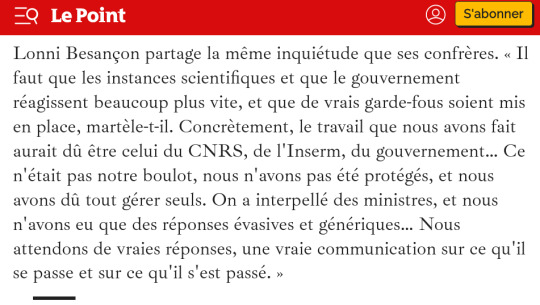
C'est très bien.
Soulignons aussi que Le Point a déjà consacré quelques articles aux magouilles à large échelle commises par Didier Raoult et ses supporters.

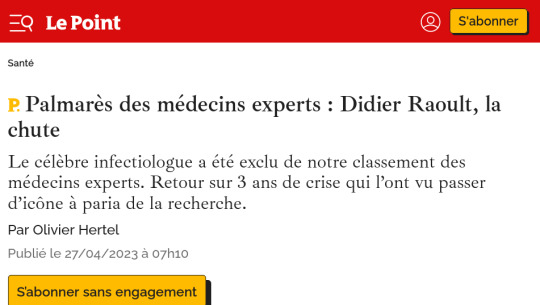
Mais...
Didier Raoult a bénéficié pendant des années de tribunes dans Le Point. Et à peu près toutes les personnes sérieuses que vous consulterez vous confirmeront qu'il y racontait beaucoup de merde.





Raoult a notamment utilisé ses tribunes dans Le Point pour y diffuser de la désinformation sur le climat. On en avait d'ailleurs reparlé en début de pandémie.
Sur Darwin, toutes celles et ceux qui se sont penchés sur les propos de Raoult sont unanimes : c'est n'importe quoi.
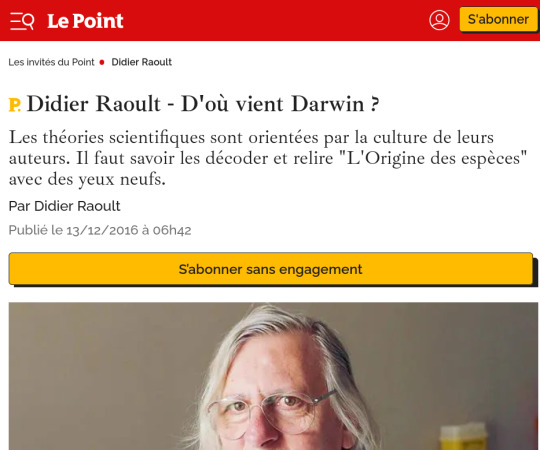


Il aimait bien jouer à "arrêtez d'avoir peur" sur plein de sujets (pas que sur le climat... et ça datait donc de bien avant ces histoires de trottinette et de coronavirus).

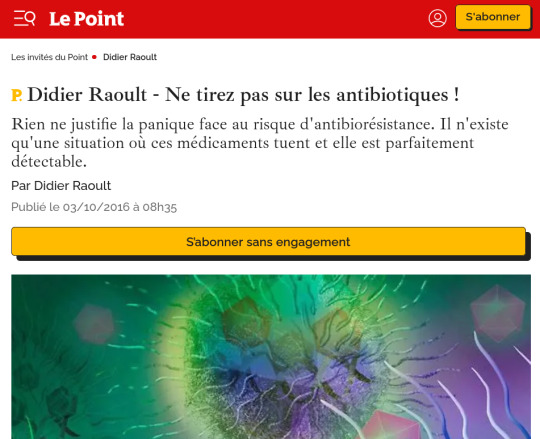
Et puis ça j'aime bien. 2017 :
Didier Raoult : Halte à la gabegie scientifique !
Nos unités de recherche françaises sont évaluées tous les cinq ans par une structure nationale indépendante qui change de nom régulièrement ; elle s'appelle actuellement Haut Conseil de l'évaluation de la recherche et de l'enseignement supérieur (HCERES). Ces évaluations n'ont quasiment aucune utilité.

Ah...
C'est intéressant.
Hein que c'est intéressant ?
Elles sont inutiles ces inspections. Elles servent à rien. C'est du pognon gaspillé. Faudrait arrêter avec ça.
Bon.
Quelques mois plus tard, on découvrait ça :
On y découvrait déjà toute une série de dysfonctionnements, annonciateurs du scandale sanitaire que l'IHU de Marseille allait provoquer pendant la pandémie de Covid.
Quelques mois plus tard encore, en janvier 2018, l'INSERM et le CNRS lui retireront leur soutien.
Ah...
Et puis quand la pandémie de Covid a commencé, il a aussi eu droit à quelques coups de pub...
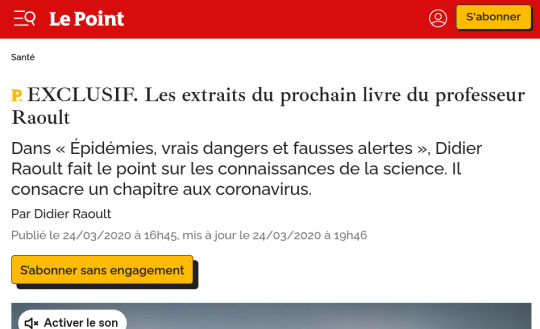


Alors oui, Le Point se sont rattrapés depuis. Et déjà en début de pandémie, il y avait eu des articles critiques sur la méthode Raoult.
Oui.
Mais j'aime bien ce dicton qui dit que le journalisme, ça ne consiste pas, face à une personne qui dit qu'il pleut et une autre qu'il dit qu'il fait beau, à donner alternativement la parole à l'un et à l'autre. Le journalisme c'est se lever du canapé, aller à la fenêtre et regarder dehors pour voir le temps qu'il fait.
Et les explications sur les graves problèmes méthodologiques, en s'adressant à un public généraliste, ça ne pesait pas lourd face aux commentaires sur le chercheur rebelle et disruptif qui dérange le sérail.
Et là, je parle de Le Point. Mais il y aurait beaucoup d'autres médias sur lesquels je pourrais écrire un billet de blog de ce style.
Donc certains ne vont peut-être même pas relayer l'excellent article publié par Science.
Alors je remercie Le Point de le faire. Je les remercie aussi pour, dans cette crise du coronavirus, s'être progressivement recentrés sur les faits, sur l'information.
Je répète cet extrait de leur article :
« Le travail que nous avons fait aurait dû être celui du CNRS, de l'Inserm, du gouvernement… »
Très juste donc.
Mais il faudrait que des leçons soient tirées. Et pas qu'au niveau du CNRS, de l'INSERM et du gouvernement. Le monde du journalisme doit aussi repenser son rapport à l'information, aux faits.
Allez, je vous remets le lien pour la route.
Et encore une fois, merci à Victor Garcia, Elisabeth Bik, Lonni Besançon, Mathieu Molinard, Frabrice Frank et Karine Lacombe.
Et merci à toutes celles et ceux qui ne sont pas cités dans l'article de Science et qui ont mouillé leur maillot et encaissé du harcèlement et du dénigrement depuis le début de la pandémie : Nathan Peiffer-Smadja, Mathieu Rebeaud, Guillaume Limousin, Alexandra Calmy, Dominique Costagliola, Damien Barraud, Jérôme Barrière, Christian Lehmann, Ari Kouts, Annick Chevillot, Samuel Alexander, etc, etc, etc, etc... J'en oublie. Et beaucoup.
Honte à celles et ceux qui s'en sont pris à vous. Honte à celles et ceux qui ont laissé faire quand leur job aurait été d'intervenir.
Merci pour le taff.
2 notes
·
View notes
Text

GET A JOB. STAY AWAY FROM HIM.
22 notes
·
View notes
Note
for the letters ask meme M O and U. for fun. mou <- said like a cat with a silly voice
AAAAAAAAAAAAAAAAUUUUUUUUUUUUUGGGHHHH CATBOY BLAAAAST *a ray of bright light disintegrates me into ash* *when it clears i have turned into a little cat*
m - name a character you’d like to have for a friend
So many…………. so many…….. i w GASP. I WANT TO HANG OUT WITH FINN MERTENS AND KOYUKI AZUMAYA AT THE SAME TIME. They would put me into life threatening dangerous situations but it would be okay because they can protect me from anything. they are trying to teach me self defense and it is NOT working i have poor reaction time and no muscles. we are also going clothes shopping and getting food. it would be great. genuinely i need to go think about what would happen if finn and koyuki got to hang out now they have. similar experiences. what if you were raised to Go Out And Fight ever since you were a little kid and also you were in some way fundamentally estranged from the common human experience. but also you were just so funny and silly and charming. anyway they’re my friends :)
o - pick a song at random. what character/ship does it remind you of
Alright playlist of nearly one thousand songs let’s see what shuffle brings me. Hmm. Shuffle brought me remains of the day from corpse bride which. Is. Much too specific. What that song reminds me of is corpse bride. Let’s try something else. OH. PORTUGAL - WALK THE MOON WHICH ISNT 100% LYRICALLY APPLICABLE BUT IT ALWAYS MAKES ME THINK OF A REALLY GOOD GRAVITY FALLS AMV I SAW SET TO IT… gives me psychic images of mabel & dipper. Ok let’s get one more song just for fun. oh i got fucking land of the dead by voltaire. isnt that the billy & mandy theme song. or whatever that show is called. anyway i only know that song exists because of my friend Darwin from Tumblr Ask Blog The Reckoning so. you guys heard of the reckoning? it’s good.
u - 3 favorite characters from 3 different fandoms and why they’re your favorites
i wonder if i can come up with all characters who r my favorites for anything other than Kin Reasons. because most of the time, it is Kin Reasons.
sgt frog: dororo. because ever since i was young i have been easily bewitched by sad pathetic loser men.
psychonauts: loboto- ok so like i didnt get the loboto hype at first when i watched the first psychonauts game i was like yeah hes… fine… i guess? hes barely fucking in that though? why do people care? and then iwatched rhombus of ruin and i. i am not immune to the Guy With A Sad Backstory effect. maybe iwould not call him my favorite psychonauts character if i had seen psychonauts more recently and had actually. Seen The Other Characters recently,. but in the period of time ive gone without directly looking at psychonauts at all my emotional response to caligosto loboto has grown exponentially, i am bewitched by his freak tendencies. God damnit i already said bewitched already. Oh well. You know what? Fine,. Let’s make it a running theme. Let’s go for a third
adventure time: BETTY. YOU GUYS KNOW WHY THE FUCK THE GUY WHO PUT SIMON AT THE TOP OF HIS LIST OF NAMES THE SECOND THE F&C TRAILER DROPPED LOVES BETTY GROF. But I would be obsessed with her either way, because ever since I was young i have been easily bewitched by chaotic unhinged in-need-of-professional-help women.
takes a bow. Thank you for coming everybody
4 notes
·
View notes
Text
@tkachukmatthew starter for thomas 'tommy' darwin

"you uh -- reckon that could happen again?"
6 notes
·
View notes
Text
Events 7.1 (before 1870)
69 – Tiberius Julius Alexander orders his Roman legions in Alexandria to swear allegiance to Vespasian as Emperor. 552 – Battle of Taginae: Byzantine forces under Narses defeat the Ostrogoths in Italy, and the Ostrogoth king, Totila, is mortally wounded. 1097 – Battle of Dorylaeum: Crusaders led by prince Bohemond of Taranto defeat a Seljuk army led by sultan Kilij Arslan I. 1431 – The Battle of La Higueruela takes place in Granada, leading to a modest advance of the Kingdom of Castile during the Reconquista. 1520 – Spanish conquistadors led by Hernán Cortés fight their way out of Tenochtitlan after nightfall. 1523 – Jan van Essen and Hendrik Vos become the first Lutheran martyrs, burned at the stake by Roman Catholic authorities in Brussels. 1569 – Union of Lublin: The Kingdom of Poland and the Grand Duchy of Lithuania confirm a real union; the united country is called the Polish–Lithuanian Commonwealth or the Republic of Both Nations. 1643 – First meeting of the Westminster Assembly, a council of theologians ("divines") and members of the Parliament of England appointed to restructure the Church of England, at Westminster Abbey in London. 1690 – War of the Grand Alliance: Marshal de Luxembourg triumphs over an Anglo-Dutch army at the battle of Fleurus. 1690 – Glorious Revolution: Battle of the Boyne in Ireland (as reckoned under the Julian calendar). 1766 – François-Jean de la Barre, a young French nobleman, is tortured and beheaded before his body is burnt on a pyre along with a copy of Voltaire's Dictionnaire philosophique nailed to his torso for the crime of not saluting a Roman Catholic religious procession in Abbeville, France. 1770 – Lexell's Comet is seen closer to the Earth than any other comet in recorded history, approaching to a distance of 0.0146 astronomical units (2,180,000 km; 1,360,000 mi). 1782 – Raid on Lunenburg: American privateers attack the British settlement of Lunenburg, Nova Scotia. 1819 – Johann Georg Tralles discovers the Great Comet of 1819, (C/1819 N1). It is the first comet analyzed using polarimetry, by François Arago. 1823 – The five Central American nations of Guatemala, El Salvador, Honduras, Nicaragua, and Costa Rica declare independence from the First Mexican Empire after being annexed the year prior. 1837 – A system of civil registration of births, marriages and deaths is established in England and Wales. 1841 – Thomas Lempriere and James Clark Ross carve a marker on the Isle of the Dead in Van Diemen's Land to measure tidal variations, one of the earliest surviving benchmarks for sea level rise. 1855 – Signing of the Quinault Treaty: The Quinault and the Quileute cede their land to the United States. 1858 – Joint reading of Charles Darwin and Alfred Russel Wallace's papers on evolution to the Linnean Society of London. 1862 – The Russian State Library is founded as the Library of the Moscow Public Museum. 1862 – Princess Alice of the United Kingdom, second daughter of Queen Victoria, marries Prince Louis of Hesse, the future Louis IV, Grand Duke of Hesse. 1862 – American Civil War: The Battle of Malvern Hill takes place. It is the last of the Seven Days Battles, part of George B. McClellan's Peninsula Campaign. 1863 – Slavery was abolished in the Dutch colony of Surinam, a date now celebrated as Ketikoti in independent Suriname. 1863 – American Civil War: The Battle of Gettysburg begins. 1867 – The British North America Act takes effect as the Province of Canada, New Brunswick, and Nova Scotia join into confederation to create the modern nation of Canada. John A. Macdonald is sworn in as the first Prime Minister of Canada. This date is commemorated annually in Canada as Canada Day, a national holiday.
0 notes
Text
around the world in 1,096 days: Day 488 🇹🇹
When We Were Birds by Ayanna Lloyd Banwo
Yejide and Darwin will meet inside the gates of Fidelis, an ancient and sprawling cemetery where the dead lie uneasy in their graves and a reckoning with fate beckons them both.
2/5 ★
Next up: Japan
>>> On deck: Serbia, Libya, Morocco, Democratic Republic of the Congo
0 notes